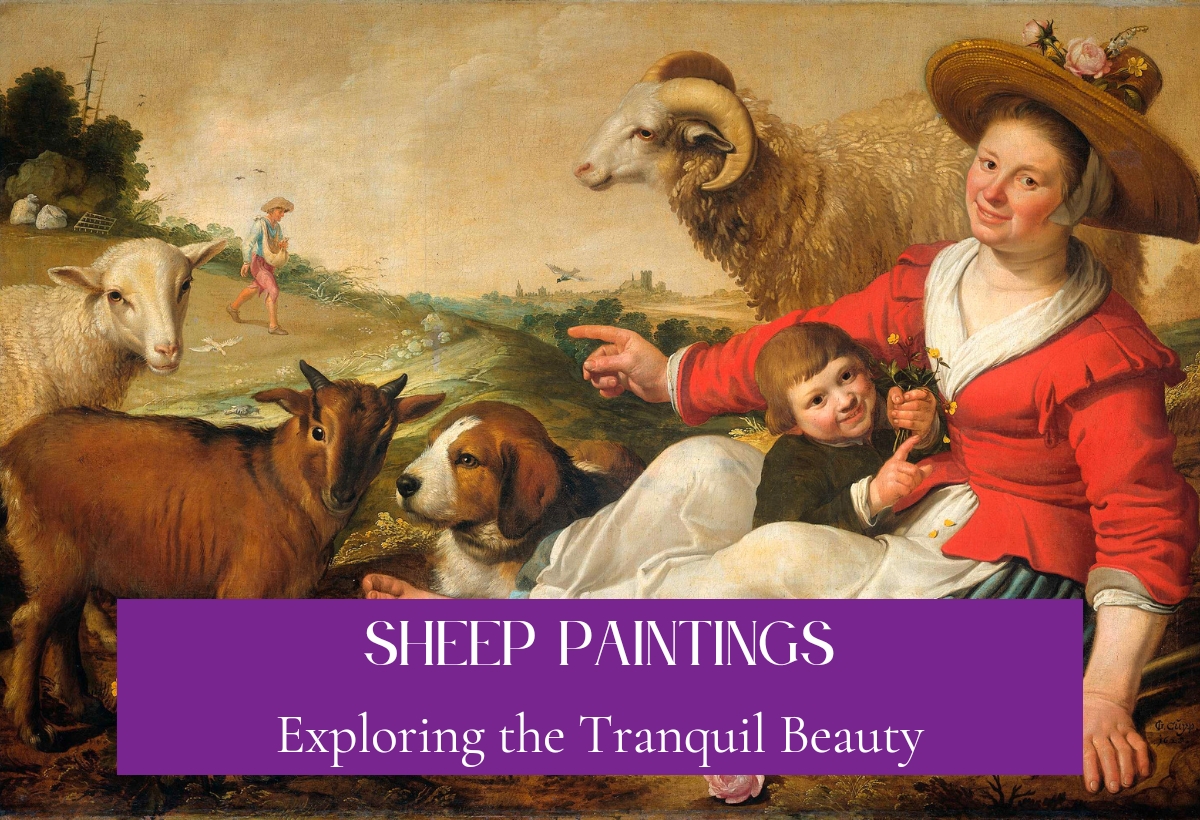Exploring the Tranquil Beauty of Sheep Paintings

Sheep, with their serene countenances and gentle demeanor, have long been subjects of artistic inspiration. From the pastoral landscapes of the countryside to the whimsical realms of imagination, sheep paintings evoke a sense of tranquility and nostalgia that captivates viewers worldwide. In this article, we delve into the enduring appeal of sheep as artistic muses and explore the diverse interpretations they inspire in the realm of painting.

1. Origins of Sheep Imagery:
Sheep have been depicted in art for centuries, with their earliest representations dating back to ancient civilizations such as Mesopotamia and Egypt. In these early depictions, sheep symbolized fertility, abundance, and domesticity, reflecting their integral role in agrarian societies.
2. Symbolism in Sheep Paintings:
Throughout art history, sheep have carried various symbolic meanings depending on cultural contexts. In Christian iconography, sheep often symbolize innocence and the faithful followers of Christ, as depicted in numerous religious paintings.
3. Romanticism and the Pastoral Ideal:
The Romantic movement of the 18th and 19th centuries embraced the pastoral landscape as a refuge from the industrialized world. Sheep frequently populated these idyllic scenes, embodying notions of simplicity, harmony with nature, and rustic charm.
4. The Influence of Impressionism:
The advent of Impressionism revolutionized the portrayal of sheep in art, with artists such as Claude Monet and Camille Pissarro capturing the fleeting effects of light and atmosphere in their pastoral compositions. Sheep became integral elements of these Impressionist landscapes, imbuing them with a sense of vitality and movement.
5. Sheep as Subjects of Character Studies:
In addition to their role within landscapes, sheep have also been depicted in character studies, where artists explore their individual personalities and expressions. These intimate portrayals offer glimpses into the unique quirks and behaviors of these beloved animals.
6. Symbolism in Contemporary Sheep Art:
In contemporary art, sheep continue to serve as potent symbols, addressing themes ranging from environmental sustainability to social conformity. Artists employ sheep imagery to provoke thought and stimulate dialogue on pressing issues facing modern society.
7. Realism and Sheep Portraiture:
Realist painters meticulously capture the intricacies of sheep anatomy and wool texture, creating lifelike portraits that showcase the beauty and grace of these animals. Through careful observation and technical skill, these artists convey the essence of sheep with remarkable precision.
8. Sheep in Surrealism and Fantasy:
Surrealist artists often incorporate sheep into their dreamlike compositions, where they assume symbolic roles within enigmatic narratives. In the realm of fantasy art, sheep take on fantastical forms and inhabit imaginary worlds populated by mythical creatures and magical landscapes.
9. Sheep in Contemporary Abstract Art:
In the realm of abstract art, sheep serve as abstract motifs and symbols, undergoing stylistic distortions and transformations that challenge conventional representations. Through bold colors, dynamic shapes, and gestural brushwork, artists reinterpret the familiar image of sheep in innovative ways.
10. Cultural Depictions of Sheep:
Sheep holds cultural significance in many regions across the globe, appearing in traditional folklore, rituals, and celebrations. In countries such as New Zealand and Scotland, sheep are emblematic of national identity and heritage, inspiring artistic representations that celebrate their cultural importance.
11. Sheep as Allegorical Figures:
Artists often employ sheep as allegorical figures to convey moral lessons and philosophical concepts. Through allegory, sheep assume metaphorical roles that resonate with universal truths and human experiences, inviting viewers to contemplate deeper layers of meaning.
12. Humor and Satire in Sheep Art:
Sheep paintings frequently incorporate elements of humor and satire, poking fun at human follies and societal absurdities. Through witty juxtapositions and clever visual puns, artists use sheep as comedic foils to highlight the ironies of contemporary life.
13. Sheep in Children’s Illustrations:
Sheep hold a special place in children’s literature and illustrations, where they feature prominently in beloved stories and nursery rhymes. From the mischievous antics of Shaun the Sheep to the endearing adventures of Babar the Elephant, sheep captivate young audiences with their charm and whimsy.
14. Sheep as Spiritual Symbols:
In various spiritual traditions, sheep symbolize qualities such as purity, sacrifice, and divine guidance. Whether depicted in religious art or contemporary spiritual imagery, sheep evoke a sense of reverence and spiritual contemplation.
15. Environmental Themes in Sheep Art:
As concerns about environmental conservation escalate, artists increasingly use sheep imagery to address issues such as habitat loss, climate change, and biodiversity. Through poignant portrayals of sheep in threatened landscapes, artists advocate for greater awareness and stewardship of the natural world.
16. Sheep in Pop Culture:
Sheep have permeated popular culture through films, television shows, and advertising campaigns, where they serve as iconic symbols and beloved characters. From animated classics like “Shaun the Sheep” to iconic brand mascots like the Merino sheep of Woolmark, sheep continue to enchant audiences of all ages.
Conclusion:
Sheep paintings offer a timeless exploration of beauty, symbolism, and cultural significance that resonates across generations and artistic movements. Whether rendered with traditional realism or abstract innovation, sheep inspire artists to celebrate the wonder and complexity of the world around us, inviting viewers to contemplate the enduring allure of these beloved creatures.
Comments are closed.